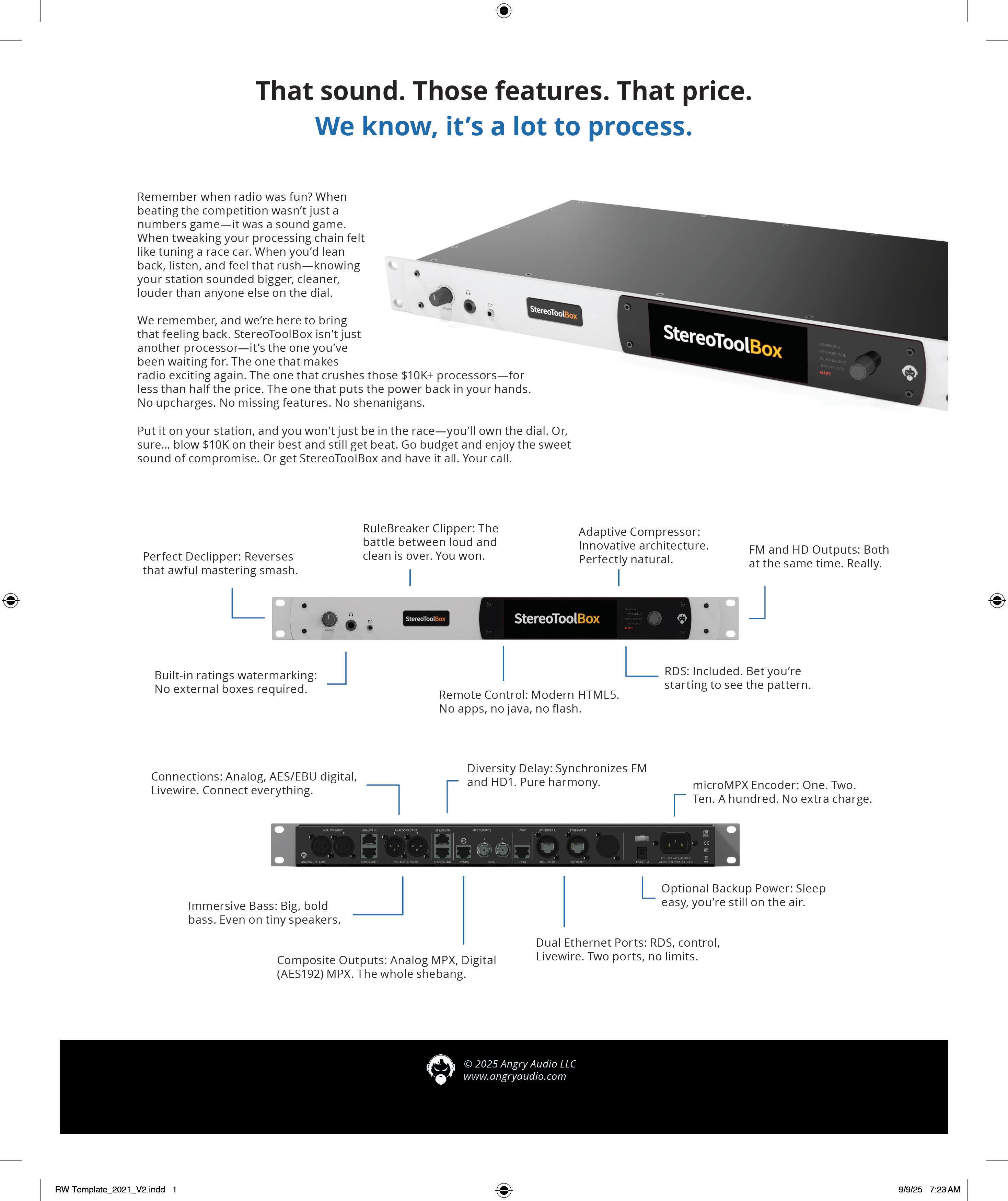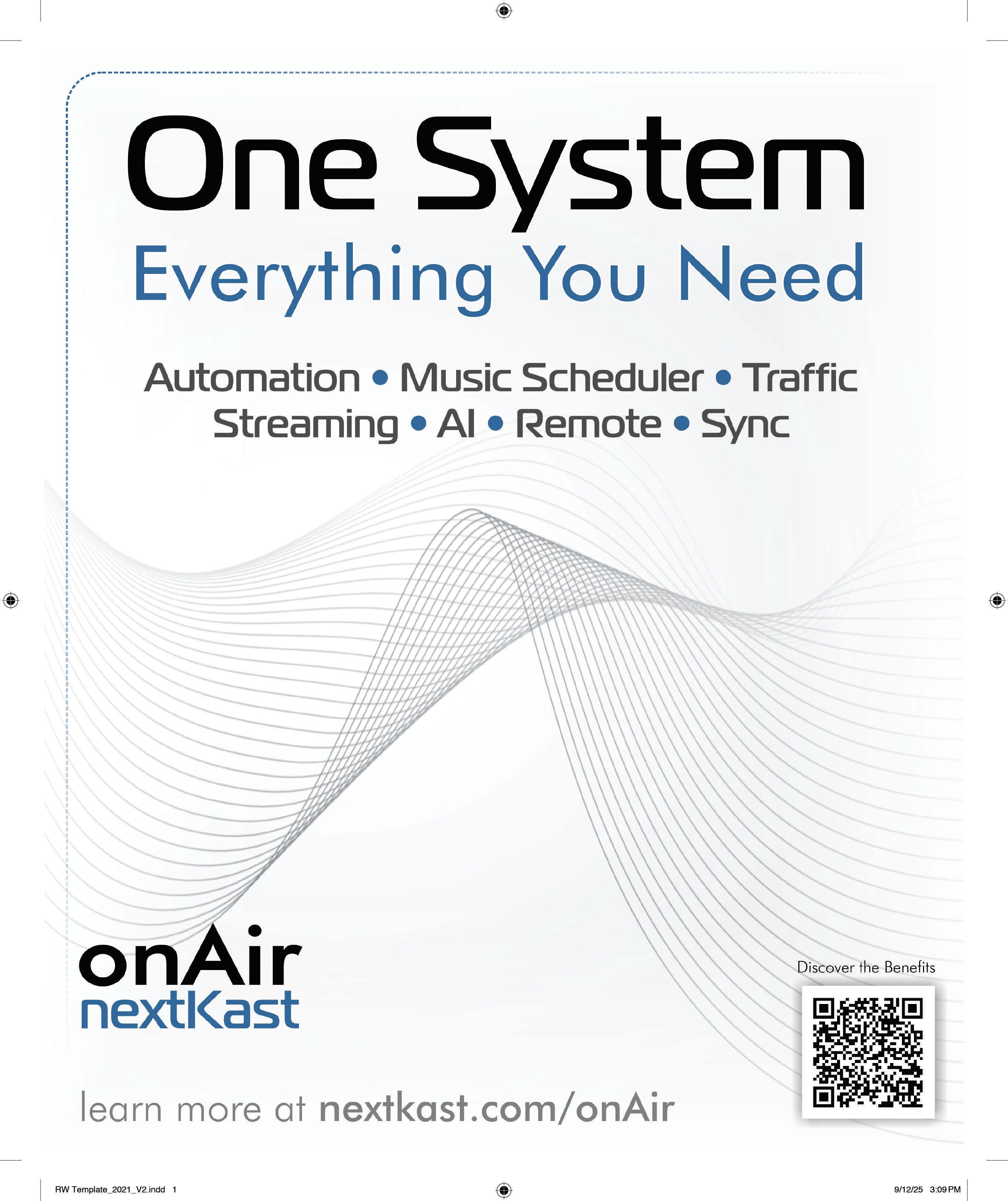Welcome to the September 24th, 2025 issue of Radio World



Welcome to the September 24th, 2025 issue of Radio World




Using AI in FM antenna modeling
A conversation with Nicole Starrett of Dielectric.


Vol. 49 No. 20 | September 24 2025 www.radioworld.com
FOLLOW US
www.twitter.com/radioworld_news
www.facebook.com/RadioWorldMagazine www.linkedin.com/company/radio-world-futureplc
CONTENT
Managing Director, Content & Editor in Chief Paul J. McLane, paul.mclane@futurenet.com, 845-414-6105
Assistant Editor & SmartBrief Editor Elle Kehres, elle.kehres@futurenet.com
Content Producer Nick Langan, nicholas.langan@futurenet.com
Technical Advisors W.C. “Cris” Alexander, Thomas R. McGinley, Doug Irwin
Contributors: David Bialik, John Bisset, Edwin Bukont, James Careless, Ken Deutsch, Mark Durenberger, Charles Fitch, Donna Halper, Alan Jurison, Paul Kaminski, John Kean, Larry Langford, Mark Lapidus, Michael LeClair, Frank McCoy, Jim Peck, Mark Persons, Stephen M. Poole, James O’Neal, T. Carter Ross, John Schneider, Gregg Skall, Dan Slentz, Dennis Sloatman, Randy Stine, Tom Vernon, Jennifer Waits, Steve Walker, Chris Wygal
Production Manager Nicole Schilling
Senior Design Director Lisa McIntosh
Senior Art Editor Will Shum
ADVERTISING SALES
Senior Business Director & Publisher, Radio World John Casey, john.casey@futurenet.com, 845-678-3839 Advertising EMEA Raffaella Calabrese, raffaella.calabrese@futurenet.com, +39-320-891-1938
SUBSCRIBER CUSTOMER SERVICE
To subscribe, change your address, or check on your current account status, go to www.radioworld.com and click on Subscribe, email futureplc@computerfulfillment.com, call 888-266-5828, or write P.O. Box 1051, Lowell, MA 01853.
LICENSING/REPRINTS/PERMISSIONS
Radio World is available for licensing. Contact the Licensing team to discuss partnership opportunities. Head of Print Licensing Rachel Shaw licensing@futurenet.com MANAGEMENT
SVP, MD, B2B Amanda Darman-Allen
VP, Global Head of Content, B2B Carmel King MD, Content, Broadcast Tech Paul J. McLane
Global Head of Sales, Future B2B Tom Sikes Managing VP of Sales, B2B Tech Adam Goldstein VP, Global Head of Strategy & Ops, B2B Allison Markert VP, Product & Marketing, B2B Andrew Buchholz Head of Production US & UK Mark Constance Head of Design, B2B Nicole Cobban

Future US LLC, 130 West 42nd Street, 7th Floor, New York, NY 10036
All contents ©Future US, Inc. or published under licence. All rights reserved. No part of this magazine may be used, stored, transmitted or reproduced in any way without the prior written permission of the publisher. Future Publishing Limited (company number 02008885) is registered in England and Wales. Registered office: Quay House, The Ambury, Bath BA1 1UA. All information contained in this publication is for information only and is, as far as we are aware, correct at the time of going to press. Future cannot accept any responsibility for errors or inaccuracies in such information. You are advised to contact manufacturers and retailers directly with regard to the price of products/services referred to in this publication. Apps and websites mentioned in this publication are not under our control. We are not responsible for their contents or any other changes or updates to them. This magazine is fully independent and not affiliated in any way with the companies mentioned herein.
If you submit material to us, you warrant that you own the material and/ or have the necessary rights/permissions to supply the material and you automatically grant Future and its licensees a licence to publish your submission in whole or in part in any/all issues and/or editions of publications, in any format published worldwide and on associated websites, social media channels and associated products. Any material you submit is sent at your own risk and, although every care is taken, neither Future n or its employees, agents, subcontractors or licensees shall be liable for loss or damage. We assume all unsolicited material is for publication unless otherwise stated, and reserve the right to edit, amend, adapt all submissions.
Radio World (ISSN: 0274-8541) is published bi-weekly by Future US, Inc., 130 West 42nd Street, 7th Floor, New York, NY 10036. Phone: (978) 667-0352. Periodicals postage rates are paid at New York, NY and additional mailing offices. POSTMASTER: Send address changes to Radio World, PO Box 1051, Lowell, MA 01853.
Please recycle. We are committed to only using magazine paper which is derived from responsibly managed, certified forestry and chlorine-free manufacture. The paper in this magazine was sourced and produced from sustainable managed forests, conforming to strict environmental and socioeconomic standards. The manufacturing paper mill and printer hold full FSC and PEFC certification and accreditation.
Out in the country or atop a skyscraper, towers have me in their grasp

Paul McLane
Editor in Chief
Ichatted recently with a colleague who works in broadcasting, telling him about my love of towers, the romance and the lore.
He told me, “I’ve never understood the fascination people have with them.”
He might have well said “All mimsey were the borogroves” for all the sense he was making to me. Not understand our fascination with towers??
I can still recall working weekends in the small offices of WNRK(AM) on Walther Road in Newark, Del., circa 1981. Just me in a tiny newsroom, with my college pal Ron Baker, the part-time jock, sitting at the on-air board on the other side of the studio glass.
Often, while waiting for my next newscast to come around, I’d step out the back door of that little building and gaze upon the station’s towers sitting in a cornfield in their glory. That door faced west, so the view was especially remarkable as sunset neared.
“My voice travels through those towers,” I thought. “Who can tell how far it goes, and how many people can hear?” That cornfield is a housing subdivision now, and that little AM station is long gone.
I also remember driving in the dusk up the driveway to the studios of Wilmington stations WDEL(AM) and WSTW(FM) in the early 1980s. I was there to sit in the studio while my friend Robin Bryson played music on cart machines and took phone calls from lonely listeners. I soaked up everything about the inside of a radio station, marveling at the reel-to-reel automation system, peeking inside the transmitter room — it was all so cool. But best of all was seeing the directional array, right out back, its obstruction beacons glimmering.
on page 4

Continued from page 3
What a thrill.
The fascination has never left me. My wife knows that if we’re driving along and I see towers, I’m going to interrupt whatever she’s saying and point them out and make an observation about whether it’s an FM or AM or both, whether it’s directional and whether it looks like the site is well kept. I don’t know if she cares, at least she pretends to.
During my years with Radio World I’ve also visited the legendary infrastructure just under the tip of the Empire State Building. And I’ve had the honor of adding my signature at the base of the broadcast mast atop One World Trade Center — true thrills for this child of New York City.
But whether it’s a candelabra mast next to an interstate, or an antenna farm in Philadelphia, or a 2,000-foot beauty
standing on the Midwest plains or a small stick next to a beat-up shack along a Virginia country road, I still find broadcast towers remarkably interesting.
And even as the definition of “radio” has morphed (for non-purists) to include streaming and apps, a tower remains for me a unique symbol of the romance of sending voice and music to listeners who are dozens or hundreds or thousands of miles away. I hope you share that wonder and that our industry never loses it entirely.
In this issue Nick Langan shares the history of one of broadcasting’s iconic tower structures. Got a suggestion for us for a future feature? Email me at radioworld@ futurenet.com. Or just drop me a line telling me about your favorite tower site, and the memories that make it special to you.
“Even as the definition of ‘radio’ has morphed to include streaming and apps, a tower remains for me a unique symbol of the romance of sending voice and music to listeners many miles away.



Writer Nick Langan The author
recently profiled processing developer
David Reaves.
How a once-controversial broadcast tower became San Francisco’s steel symbol in the fog
You can see it from almost anywhere in the City by the Bay. No other landmark can make that claim — not the Golden Gate Bridge, nor any of the city’s skyscrapers. Including the ground, the tower has six levels and hundreds of antennas.
Sutro Tower has stood for 52 years in San Francisco, often visible shooting up above the city’s trademark fog. For many residents, it has become a sign that welcomes them home.
The structure has come a long way to becoming a Bay Area icon. To know its story requires a visit to a moment in time when TV broadcasting was still novel.
In San Francisco, determining the best place for a broadcast TV tower was a question that didn’t have an easy answer in
the days before Longley-Rice-based studies, for example, were available.
Engineer Bill Ruck is perhaps the person who knows the most about its history; he shared the chronology.
By 1960, the five primary Bay Area TV stations were fielding complaints of poor reception, which required viewers to reposition their rabbit ears to get a clear picture. There were two disparate sites. Channel 7, KGO(TV), had its tower at the site of the La Avanzada mansion, once home of Adolph Sutro, a city mayor in the late 1800s.
ABC planned to reconfigure the mansion into a broadcast facility for KGO, their new local TV station. By 1949, KGO began transmitting from a 580-foot broadcast tower adjacent to the mansion. KPIX(TV) Channel 5 would join KGO there.
The San Francisco Chronicle’s KRON(TV), Channel 4, went on the air in 1949 from a tower on Mount San Bruno.
KQED(TV), Channel 9, joined them in San Bruno in 1954, and Channel 2 KTVU(TV), which signed on in 1958, did the same. KGO would propose a tall tower at Mount Sutro, while KRON proposed a tall tower on San Bruno.
Ultimately, a tall tower on San Bruno was blocked by the FAA, as it was much too close to San Francisco International Airport, about two miles to the southeast.
“That’s why Sutro Tower was built,” Ruck said.
In 1968, four TV stations — KRON, KGO, KPIX and KTVU — came together to form Sutro Tower Inc.
Initial designs envisioned a 1,200-foot tower that included a restaurant and observation deck. Opposition ensued. Ultimately, a height of 977 feet was settled upon. Construction began in 1971 and was completed a year later. Antennas were mounted in 1973, and on July 4, the first broadcast from Sutro took place.
How did Sutro become the regional symbol that it is today?
Cody Hmelar, former chief engineer for Salem Media and an instructor at the University of Pittsburgh, grew up in the Bay Area. He said the tower became more celebrated by the early 2010s, as what he described as “contemporary hipsterism” rose.
It was simultaneous to the growth in popularity of “Karl the Fog,” a personification for the city’s trademark low-cloud layer.
The Clarendon Avenue location, he said, sets it apart from other Bay Area towers, leading to its appearance in local art, tattoo designs and even on the San Francisco City Football Club’s uniform badge.
Managing Sutro today
Raul Velez, 56, recalls looking at Sutro Tower out of his bedroom window a few years after it was completed.
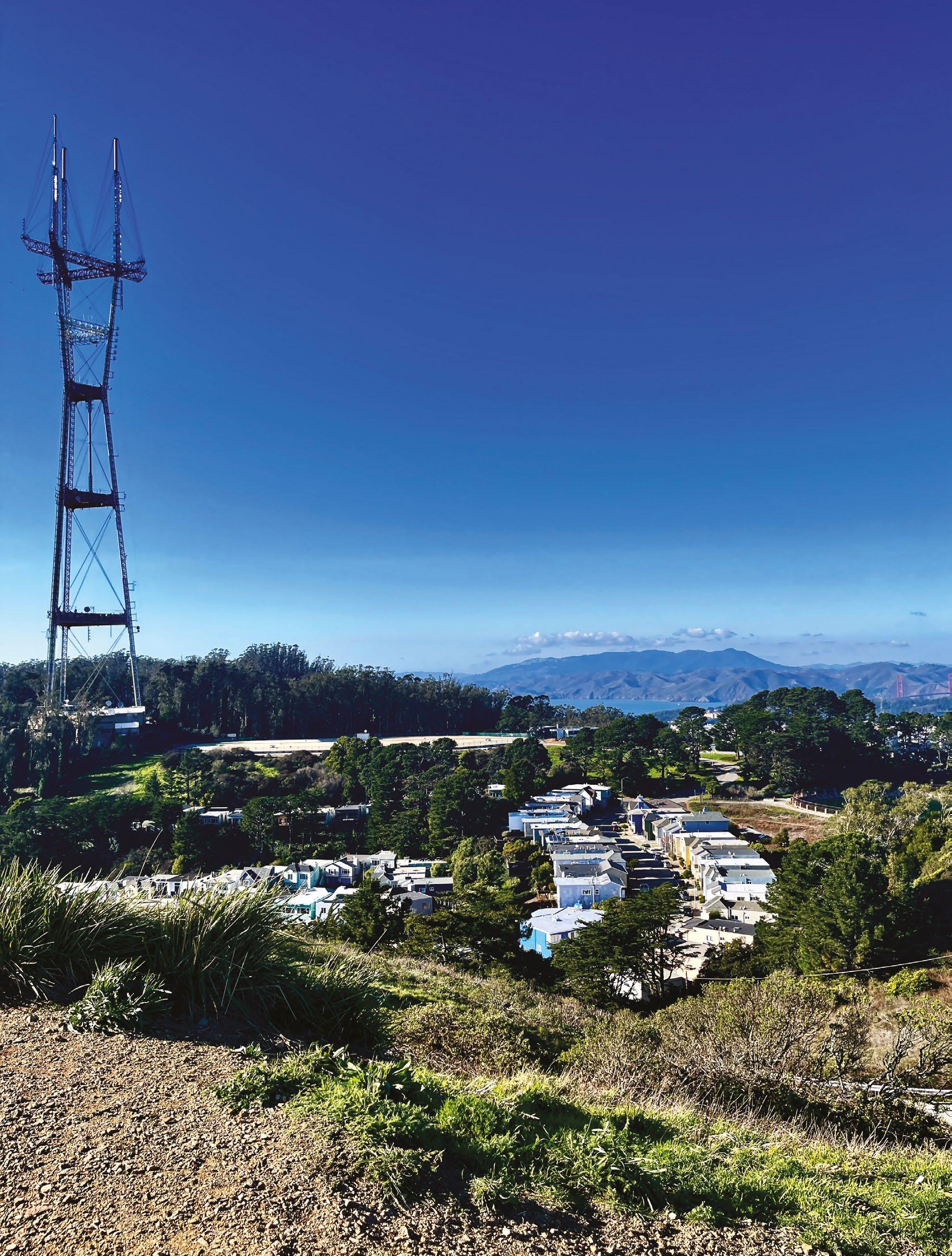
“I didn’t know it at the time, but it was my source of [TV] cartoons, so it was really important to me,” he said.
Velez has been involved in Bay Area radio engineering since 1989, and he was Bonneville’s director of engineering when Sutro’s primary RF consultant, Peter Eckmann, encouraged him to apply after the retirement of COO Eric Dausman.
“When I talk to folks and say ‘I work for Sutro Tower,’ they’re like, ‘What?’”
From a distance, Velez remarked, Sutro looks static, but work is happening nearly every day. He occupies an office in the reinforced concrete transmission building at the base, which also houses signal handling and transmission


96.5 KOIT(FM), 98.9 KSOL(FM), 104.5 KNBR(FM) and translator 93.7 K229DD(FX) transmit atop Sutro Tower from separate antennas. A Dielectric DCR-S antenna is visible here; ERI and Jampro antennas are also used.
equipment. Sutro Tower operates with a team of five employees handling administrative, power and building maintenance, supported by contract security and external contractors like Full Wave Tower & Broadcast for specialized tasks.
TV stations KGO, KPIX, KRON, KTVU, KQED, KRCB, KPYX, KPJK, KCNS, KDTS and KFSF all transmit from Sutro today, representing ABC, CBS, Fox, PBS, CW and TelevisaUnivision.
On FM, 96.5 KOIT(FM), 98.9 KSOL(FM), 104.5 KNBR(FM) and translator 93.7 K229DD(FX), which relays Chinese-language 1400 KVOT(AM), call Sutro home.

Two 102.5 LPFM stations maintain a timeshare from Sutro: KXSF(LP), operated by San Francisco Community Radio, and KSFP(LP), the San Francisco Free Press.
Seven amateur radio groups maintain facilities there, including the San Francisco Radio Club (W6PW). While each broadcaster typically sends over their engineering contact for maintenance, there are plenty
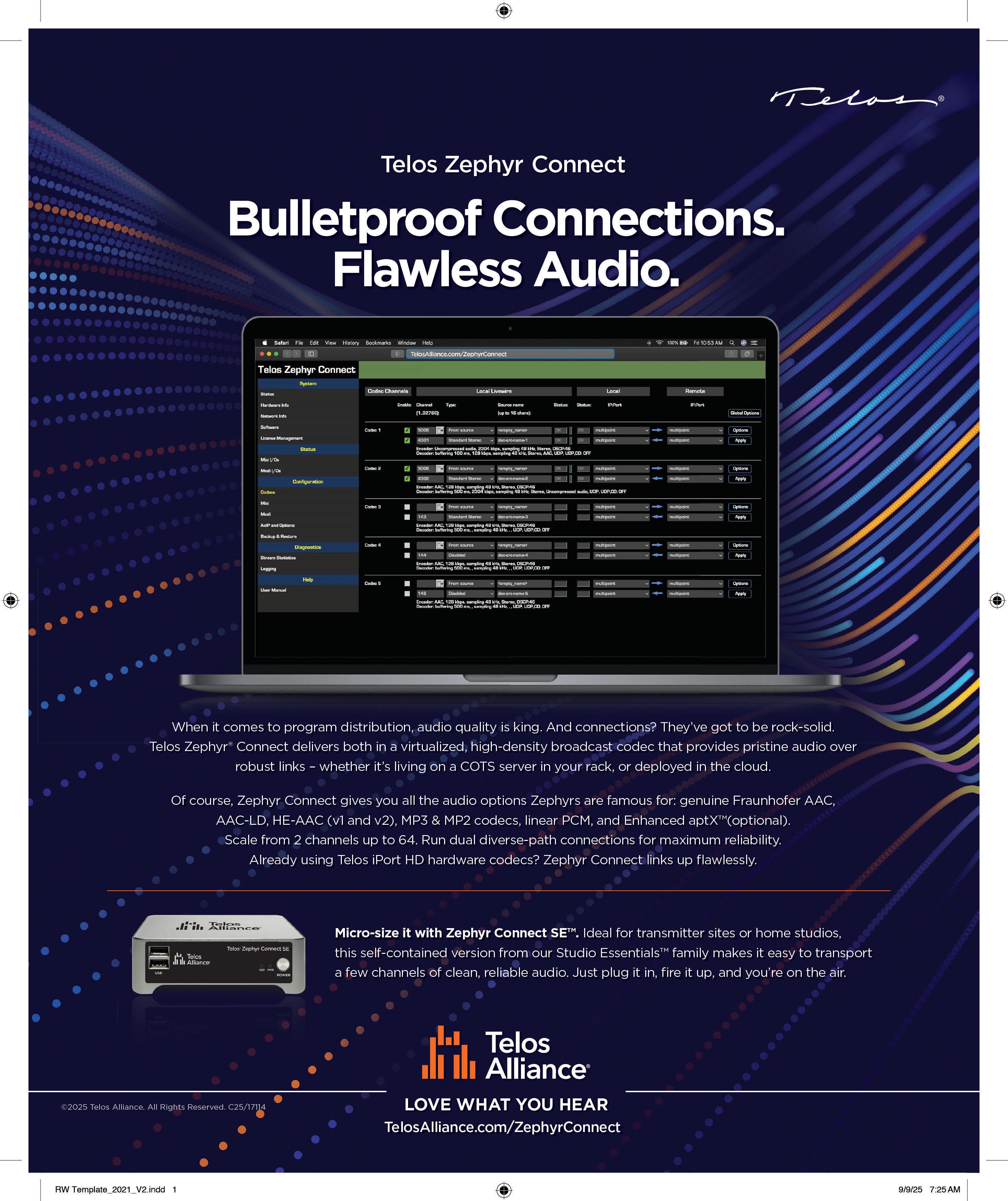
The Sutro structure contains 3.7 million pounds of steel, embedded in 15 million pounds of buried concrete. The concrete base shifts the tower’s center of gravity below ground level, enabling it to withstand high winds and seismic events.

of other hands-on endeavors the Sutro team has spearheaded. That includes a 360-degree, rotatable, movable, zoomable panorama of the tower, available at explore.sutrotower.com. Velez said the feature consists of 1,300-gigapixel images placed together, produced by the Portland, Ore.-based Panogs.
At nearby Glen Park School, third-grade teacher Sheila Tenney starts each school year by having her students draw the familiar Sutro Tower.
Other consolidated sites exist, like Chicago’s Willis Tower or New York’s Empire State Building. But Hmelar thinks of Sutro as Empire’s “artsy cousin” thanks to its unique design. Its closest analogy is perhaps Paris’s Eiffel Tower, hosting multiple broadcasters in one location, though Sutro lacks the tourist amenities.
There are seven generators and an associated fuel supply that can keep equipment running for up to three days without power.
The tower is always under maintenance, including current repainting of its cladding panels. Sutro removed its vertical cladding to comply with seismic code. Its inside panels are now thicker to improve rigidity, which also allowed the panels to be painted offsite. The outside horizontal cladding panels are next, and Velez expects the paint job to be completed by 2027.
Velez’s duties are not without stress. But by all accounts, the relationship between the 977-foot tower and its neighbors is as good as it has ever been. He credits the teams at law firm Womble Bond Dickinson and at Lighthouse Public Affairs for improving communications between the neighbors and the city of San Francisco.
“We’re here, I can be reached 24 hours a day,” he said.
And if you look up in the City by the Bay, you’ll get a glimpse of the tower, peaking through the fog.
You can read a longer version of this story with more photos at http://radioworld.com, keyword Sutro.

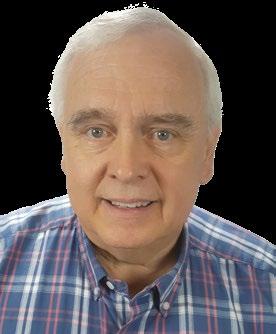
John Bisset CPBE
The author is in his 34th year of writing Workbench. He handles western U.S. radio sales for the Telos Alliance and is a past recipient of the SBE’s Educator of the Year Award. Send your tips Workbench submissions are encouraged and qualify for SBE recertification credit. Email johnpbisset@ gmail.com
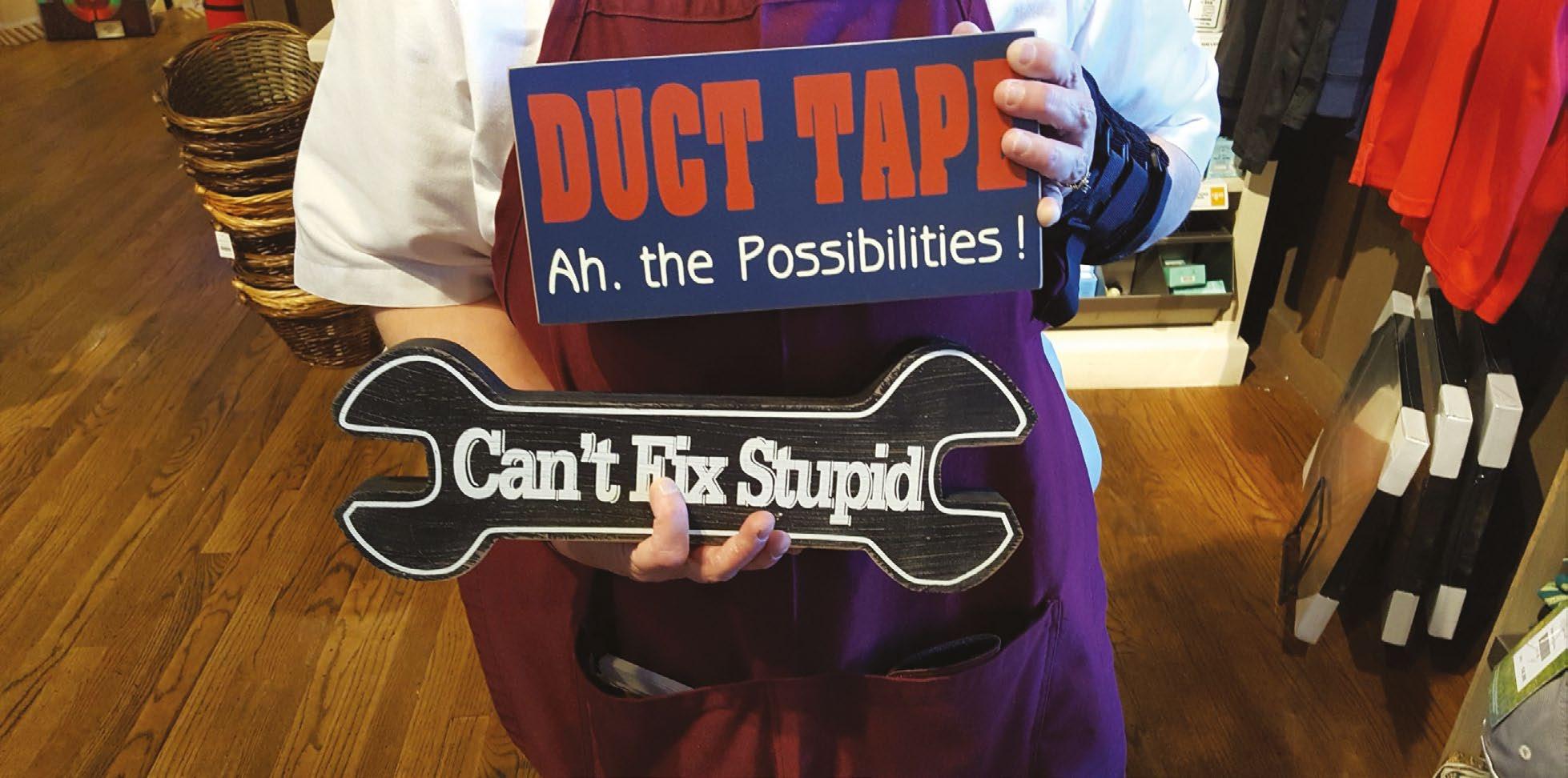
Any suggestions beyond duct tape or a
Michael Baldauf, Colorado’s “Technoguy” and fellow Radio World contributor, poses what seems like a simple question: What’s the best way to change a floodlight bulb?
Many transmitter sites use these big bulbs, typically mounted deep in their fixtures. But their threads can jam, or the bulb bases and sockets can corrode over time, especially outdoors, making removal difficult.
Then you have to grab a ladder, shatter the bulb and twist the pieces out with needle-nose pliers (after turning off the power, of course).
Michael has tried using a suction cup attached to the end of a pole, with some success. He’s had better luck by taking a wad of duct tape or similar, jamming it against the face of the bulb and screwing the bulb out.
Michael wonders if Workbench readers might have additional ideas for this situation.

One suggestion is to get in the habit, when first installing your bulbs, of applying a layer of Vaseline or similar brand petroleum jelly around the threads of the bulb. Make sure it’s a very thin layer. Heat from the light can cause excessive amounts to drip and cause a fire hazard.
Shake, rattle and roll!
There’s an odd noise or rattle in your studio. How do you find the source?
Paul Sagi says that he would play a classical guitar CD whenever someone in a studio complained of hearing something rattle. It might be a loose loudspeaker binding post, keys on a console, whatever. Classical guitar played at moderate volume shakes things up, helping you find the source of the noise.
Phil Schoenthal writes to say that he enjoys the experiences and advice offered by readers in our Workbench column. He shares some of his own broadcast experiences on Archive.org. The electronics DIY site at https://archive.org/ details/@thadood is neat to check out and kind of takes over where earlier DIY sources like Panaxis Productions and Ramsey left off.
There are a lot of neat ideas, though unfortunately most of the FM transmitter kits can’t be used in the United States except into a dummy load. Phil says it’s too bad that they do not seem to offer AM transmitter kits. In this country, AM kits would make more sense, with Part 15 possibilities, for both radiating and AM carrier current.

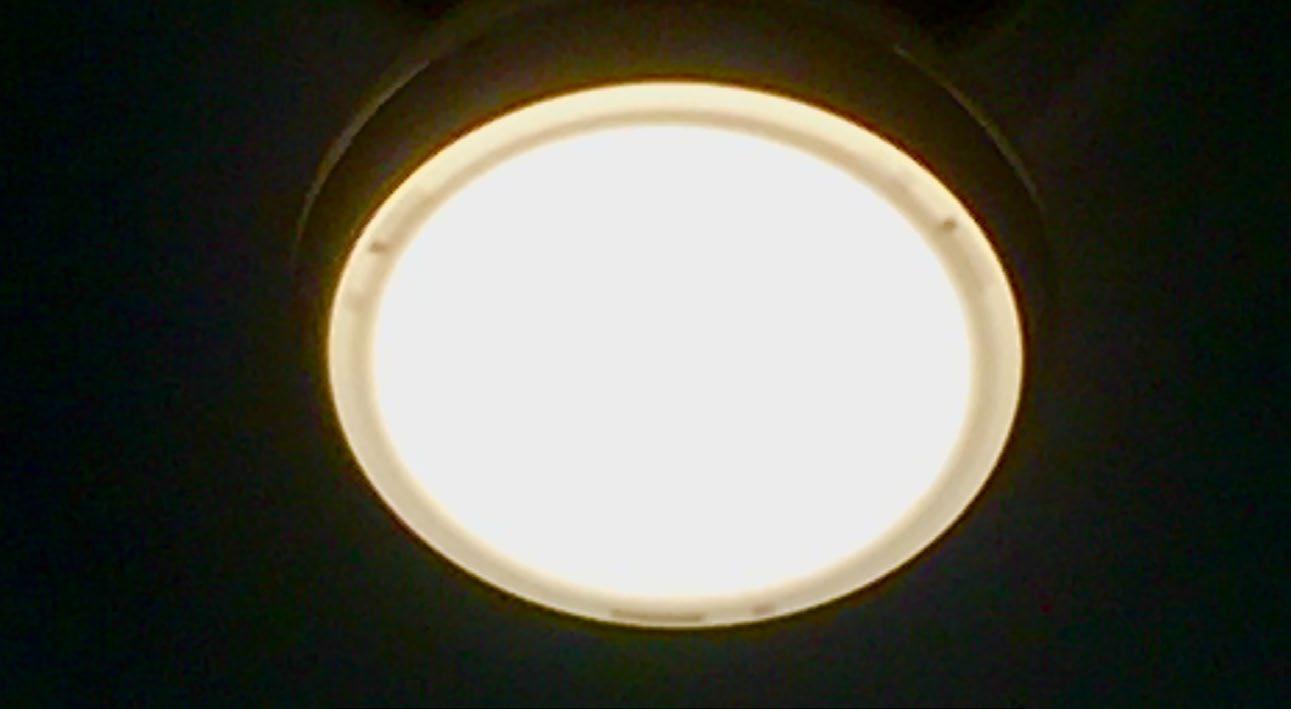
Speaking of which, Phil points out that for carrier current coupling, a linear power supply, with a full isolation stepdown transformer, is essential for reducing RF feedback. And yes, that GREEN GND wire may indeed have to be dealt with, and isolated, as well.
(Radio World’s Nick Langan wrote an interesting article about carrier current recently. At http://radioworld.com, search “Connecting Currents on Campus.”)
Frank’s $30 network tester
Network cable testers like the unidentified model shown below are useful but can be costly. Frequent tips contributor Frank Hertel sent along a link to a $30 network cable tester that rivals the more expensive models.
You get a lot of features for $30 and can test all kinds of cable connectors including RJ-45, RJ-11, USB and BNC. It will even test installed wiring or patch cables.
The instrument can also test from two remote points, using a remote tester that is nested in, and removable from, the main unit. An LED indicates faults, while a beep
Above
Fig. 1: The tight fit between bulb and receptable can make removal harder.
Below
Fig. 2: IP connector testers like this one are helpful but sometimes costly. AliExpress offers a $30 model as described in the story.
Below right
Fig. 3: Inside a water pump.

provides audible annunciation of the various test results. There’s even a low-battery indicator.
Many of us now work in or with IT, so this should be a useful addition to the toolbox. At the AliExpress website search for “professional 4-in-1 network cable tester.”
Generators keep their cool
Dave Porter, G4OYX, enjoyed our column of tips about generator maintenance from Buc Fitch.
Dave points out that in the U.K., the term “generator” is used for DC (direct current) output, while “alternator” is used for AC (alternating current) outputs.
In that column Buc recommended checking genset fluids, but Dave points out that we didn’t mention the coolant. Good point. Checking coolant level is up there with monitoring oil and fuel levels, and can be overlooked. Dave reminds us also to check the antifreeze if you live in a part of the country where temperatures get anywhere near that point.
Even in warm climates, did you know that antifreeze raises the boiling point of your radiator coolant? It also has additives that guard against corrosion and rust; and the formulation lubricates the water pump and engine seals. So it’s not just for cold weather locations. Oh, and Dave points out one other feature of antifreeze: Namely, it has the most amazing property of finding every leak in the system!
Ever wonder what the inside of the water pump looks like? See the accompanying photo.
Dave is a former senior transmitter engineer with the VOA and BBC. His son Matt, G8XYJ, is now a transmitter engineer at the famous Woofferton transmitting site in England. He makes a brief appearance during a tour of the 250 kW facility that you can watch at www.txfactor.co.uk/ episode-29.html
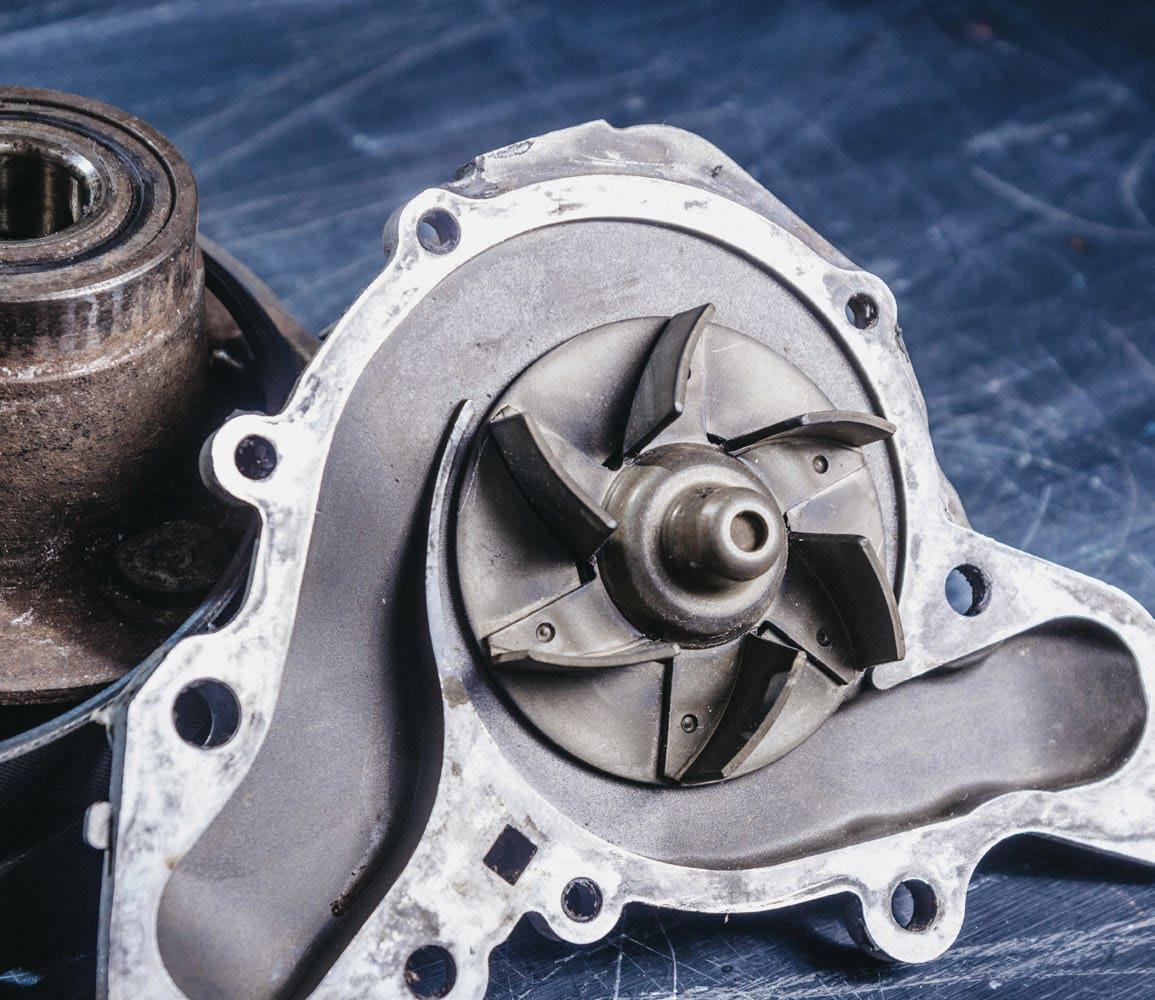


Mark
Lapidus is a veteran multi-platform media and marketing executive.
“Dust on the wind Boots on the ground Smoke in the sky No peace found
The drums roll slow Tell me, brother, where
Interesting song lyrics, right?
If you like the ’70s rock sound, you’ll also find that the music is quite good.
If I didn’t know “The Velvet Sundown” was a band created by artificial intelligence, I might be a fan. Spotify calls them a “synthetic music project … not quite human … not quite machine … The Velvet Sundown lives somewhere in between.”

Haters quickly jumped to comment, but the band continues to rack up streams in the millions.
As I write this, broadcast radio is cautious about giving this “band” airplay. Is it the right approach? While I don’t have an answer, it’s clear that radio stations need someone familiar enough with artificial intelligence to proactively decide how to interact with it, far beyond the use of AI DJs.
Thought starters for using AI to your advantage:
• Research: Stations are sitting on a gold mine of audience data received from listeners via social media platforms, email, voice notes and messaging apps. Convert your data into text, upload to AI and bingo, you’ve got aggregated audience insight. If a messaging app is in your communication loop with listeners (see my previous article about WhatsApp), you can tap phone numbers from this
“As ridiculous as it sounds, AI will help us scale emotional intelligence to analyze how listeners feel about what they are hearing. ”
group to ask specific questions about music, personalities or talk show topics.
Emotional intelligence: Humans who develop this skill are more successful than those who don’t. As ridiculous as it sounds, AI will help us scale emotional intelligence to analyze how listeners feel about what they are hearing. Tools like openSMILE can extract voice attributes which can then be emotionally classified to understand how listeners feel. MarketsandMarkets forecasts the emotion AI market to grow from $2.74
• Show Prep: AI is your expert for coming up with hot topics, themes and even sound design. And after the show, taking the transcript, feeding it into AI and telling it to summarize content will provide an ongoing history to prevent repetition. You can also prompt it to expand themes for future shows.
• AI voices: Whether or not you opt for full-time AI DJs, consider how to use AI voices in supporting roles. For example, AI can voice comments or questions about a topic you want to seed for live callers, or perhaps do your traffic or weather. Ever had a vigorous debate with an AI voice? The controversy alone will generate interest.
• Translation: A friend of mine recently spoke Japanese, sort of. AI can now translate your hosts’ voices into other languages while retaining tone and personality. That version could be run on an HD channel or stream.
This could be compelling in a market with a significant second-language audience like Miami or Los Angeles.
Authenticity matters, so AI always needs to be acknowledged to the audience. This is important until it becomes so common that it will go the way of “portions of the day’s programming are reproduced by means of electrical transcriptions or tape recordings.”
It’s difficult to discuss AI integration without acknowledging the fear that it will eliminate more jobs. Radio has been running lean for years: small staffs, long hours, tight budgets. However, another way to look at AI is as a tool for relief and support, especially for those still dedicated to America’s number one audio medium.
Read more about this topic in the 2025 Radio World ebook “AI Revolution in Radio & Streaming” at http://radioworld.com/ ebooks.

Writer Paul McLane Editor in Chief
In 2022 the Federal Communications Commission allowed computer modeling of directional FM antennas. The action was prompted by a petition from antenna manufacturers and Educational Media Foundation.
Dielectric was a key proponent. It said the new rules would ease product-to-market timelines, helping broadcasters upgrade facilities quickly.
We asked Director of Electrical Engineering Nicole Starrett about the role of AI in its process.
What is AI-driven simulated modeling of antenna patterns?
Nicole Starrett: This simply represents using AI tools to do the same types of physical antenna pattern studies that we have provided for decades here at Dielectric. We take all available tower information and bring that together with the FCC protect envelope and any customerspecific requests, then plug it into our software and AI tools that we use to optimize each pattern.
Specifically, we use HighFrequency Simulation Software, or HFSS, to help drive the computer simulation process for virtual antenna design. HFSS eliminates the lengthy setup and breakdown times of physical models.

Computer modeling itself has been around in AM and in other contexts for some time. How does AI-based modeling improve upon what computer modeling could already do?
Starrett: Computer modeling has existed in many capacities for decades and has been in use at Dielectric since the early 2000s. The beauty of adding AI as a layer on top of that simulation is that it takes out a lot of human error and the human time that goes into these simulated patterns.
software that we use, but the AI portion is Ansys.
Can you describe the basic process of modeling?
Starrett: It begins with our customers. We have a conversation with the customer and our sales team to identify the desires for their pattern and discern their coverage requirements. They detail the style of antenna they prefer, how much power they can put into it and their designated market area. We then gather all physical information about the tower, including leg size, face size and orientation, which helps us understand the potential aperture of the antenna.
Nicole Starrett
That is further aided through OptiSlang, an optimetric AI tool that reduces the labor involved in pattern development to one hour or less. Ultimately, transitioning from a physical to a virtual design process allows us to optimize radiation patterns without time and material constraints.
Going from manual patterns to simulation already removes many errors, but it also is time-intensive. It requires watching the pattern as it develops and using your own engineering intuition to adjust that pattern, so it arrives at the customer’s vision. With AI, you can give it a set of parameters, objectives and geometrical constraints. It will then apply all of those to your model and pattern to optimize it without requiring a human to think about it.
What third-party AI tools, if any, do you use?
Starrett: We use Ansys Electronics Desktop and Ansys OptiSlang programs for the AI portion. We do have some internal data manipulation
We take all that information and build a model of the antenna and tower in HFSS, then run a starting pattern to get a good idea of what it looks like from a performance standpoint. From there, we will determine our objectives, our geometrical constraints and all the information that needs to go into the OptiSlang for the AI portion. We plug it in, run the program and review the results. Those results deliver a selection of patterns we can present to the customer.
That transitions into an iterative process where we make gradual adjustments and improvements, such as shifting the direction of signal. Those constraints are sent into OptiSlang once again, and the process repeats until establishing the precise pattern that the customer wants.
For someone not familiar with the process, what kind of problems are avoided with this approach? I’m thinking here of issues mentioned on your website
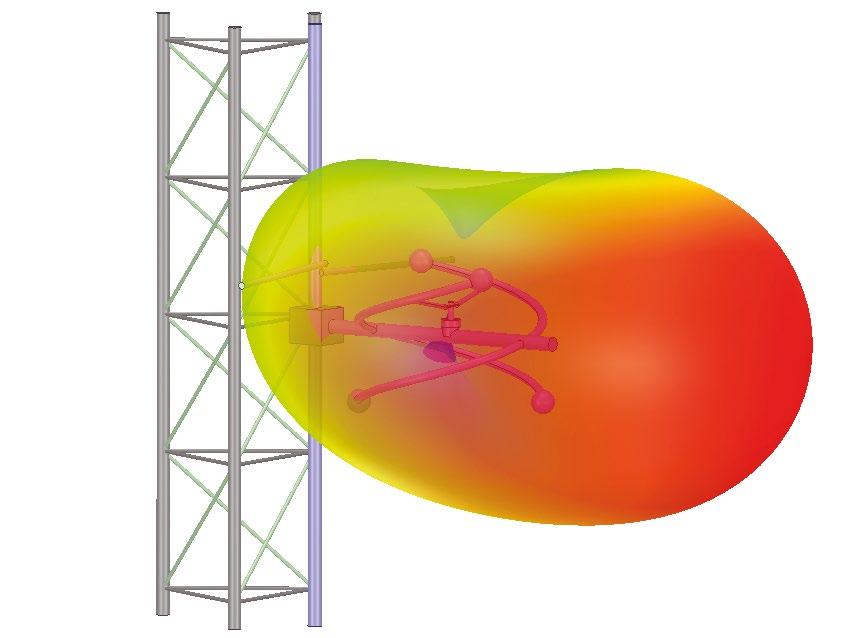
like problems with the range or anechoic chamber, or the reliability of azimuth patterns and H/V ratios. Starrett: We have decades of experience successfully establishing physical range patterns. Nevertheless, the process relies on humans to physically adjust and measure the model. Some technicians are incredibly precise, but you never know how much error the process will introduce. Moving to simulation has helped to eliminate many of those errors. With HFSS, we can produce exact point-to-point measurements.
We know exactly where everything is. As for anechoic chambers, they’re somewhat lossy and essentially provide an imperfect environment.
In what other ways does Dielectric use AI technologies in its workflows, in making products or in running your business?
Starrett: Dielectric uses AI in some of its product designs, including filters and combiners. Ansys offers tools to optimize filter topology as well as combined performance.
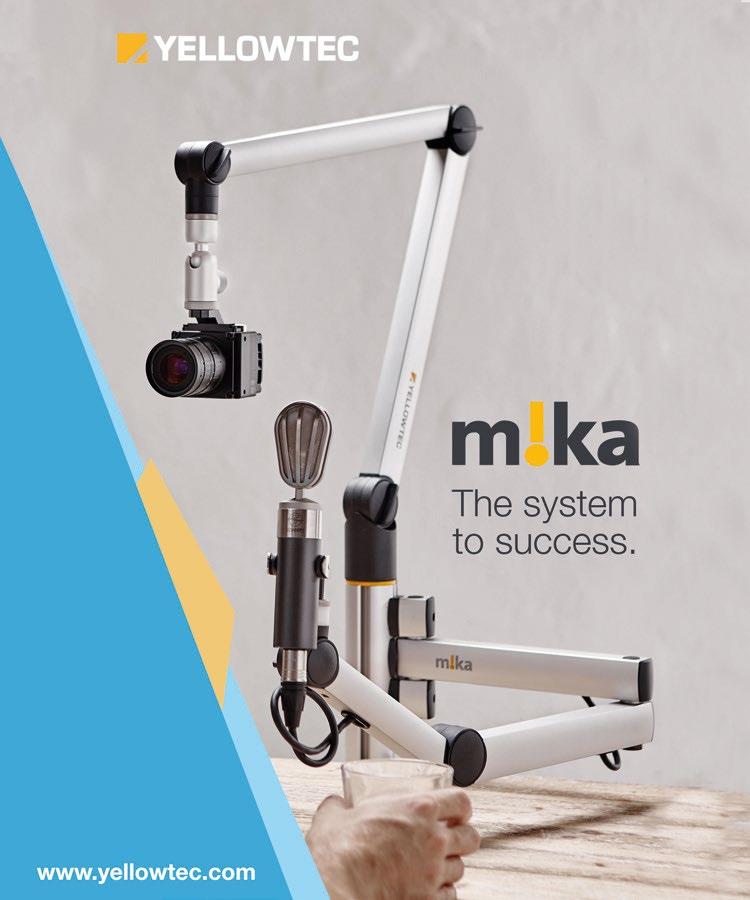
Above Ansys HFSS model of a ring-style antenna bay on a tower during preparation for AI optimization.

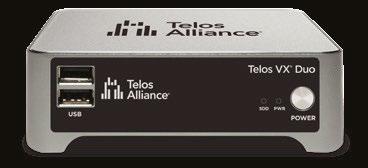




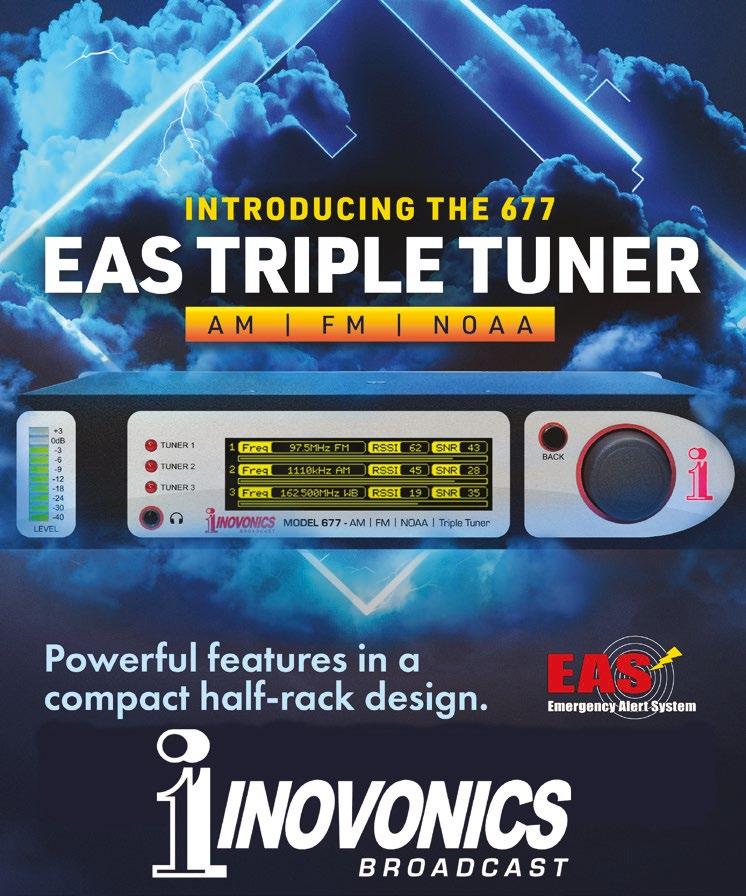

The Buyer’s Guide section appears in every other issue, focusing on a particular category of equipment and services. It is intended to help buyers know what’s on the market and gain insight into how their peers are using such products.
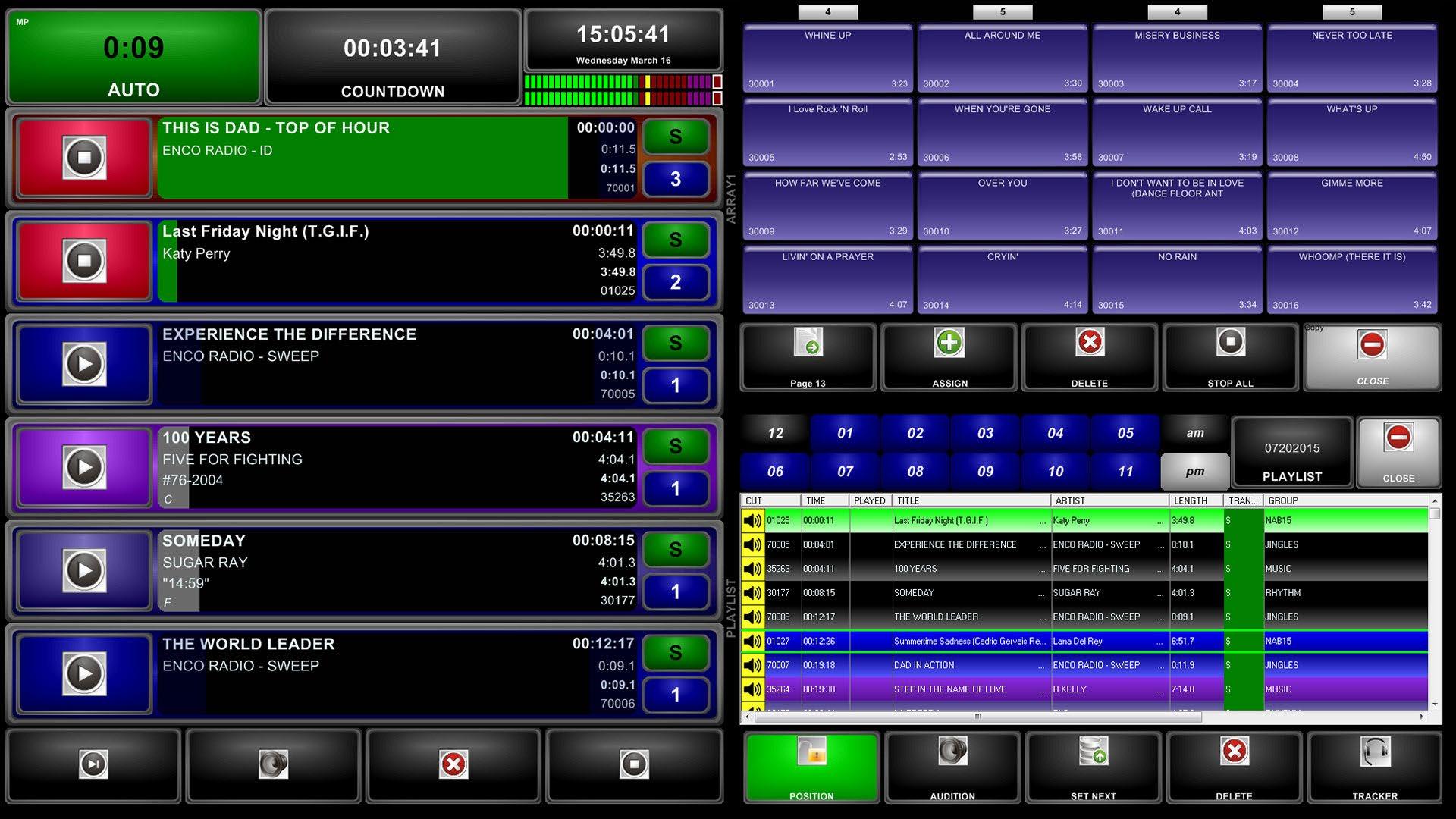
Ohio NPR affiliate looks to expand automation system in new studio facility
WYSO(FM)’s audience reach expanded when the station relocated its transmitter to a new tower site 10 years ago. The project, managed through JMS & Associates, opened the NPR member station to more than 2 million potential listeners from its new position between Dayton and Cincinnati.
The station was sold by Antioch College in 2019 and is now licensed to Miami Valley Public Media.
On the studio side, there is WYSO’s well-established ENCO DAD automation system, now in use for more than 25 years. Jim Stitt, president of JMS & Associates, has worked with ENCO and WYSO over time to update the technology, modernize its workflow and ensure WYSO staff remains up to speed.
“DAD has always been a very straightforward and intuitive system,”
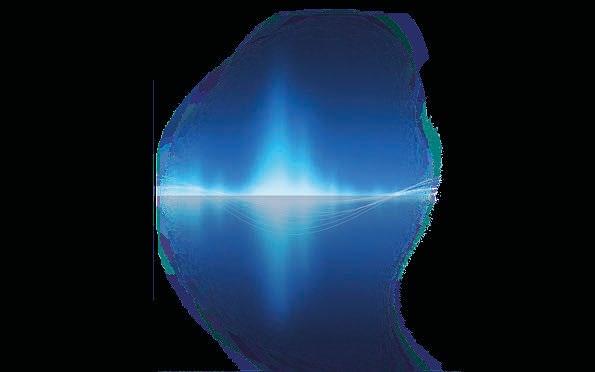
said Stitt. “That remains true whether working remotely or in the studio.”
JMS & Associates is now at work on WYSO’s new studio facility. The ENCO DAD ecosystem will expand with the deployment of WebDAD, which provides browser control for DAD automation and is used for remote production work including voice tracking.
“There is a lot of voice tracking work,” said Stitt. “They do a lot of production for local news and public affairs, and there is a performance studio where they do multi-track music recordings of live bands and later edit pieces into a larger production. It’s about to grow as our new studio facility prepares to launch.”
Stitt says WYSO’s facility will house two on-air studios, one production studio, an event space with a stage, and four edit booths all connected via a WheatNet AoIP network.
“We’re going to achieve a lot with the DAD and WheatNet integration,” he said. “That integration will also include the TOC, server room and several network blades for importing other sources into the facility.”
Super Hi-Fi unveiled an update to its Voicetrack Fusion platform. Version 2.0 includes approximately 100 new features, according to the company, which says the improvements are based on user feedback and aim to make the voicetracking system “more intelligent and human.”
It is a browser-based platform that combines recording, production and shift management into one workflow. It is designed for both on-air talent and station managers. The company says the system eliminates many of the manual steps that “traditionally make voice tracking a chore.”

“DJs can simply hit record, while the platform automatically handles segues, ducking and mastering with Super Hi-Fi’s VoiceIQ engine, ensuring every track sits perfectly in the mix and always hits the post,” it states.
When using the platform, managers have access to tools for scheduling shifts, assigning jobs, monitoring progress and automating reminders. Super Hi-Fi said this can reduce hours of production to minutes.
Version 2.0 updates include a reduced settlement time that allows DJs to record voice tracks as close as 10 minutes before airtime, thanks to a platform-wide 3x AI performance boost.
Also, a Voice Swap feature enables talent to record and transform their track into different DJ voices or personas. “This lets a single announcer deliver an entire day’s programming in under an hour — while presenting as multiple on-air personalities.”
Info: www.superhifi.com
The Highlander Network broadcasts on WNAS 88.1 FM and is located at Floyd Central High School in southern Indiana. Tim Dench, the station manager and the high school’s instructor for the radio program, has been teaching for 51 years and using DJB products for the last 11 years. He endorses DJB for its quality and ease of use.
New digital audio management software was part of an upgrade to the facilities of WNAS.
“I have designed or overseen construction of 11 studios in my career, and DJB Zone Wide Area automation software was our obvious choice based upon their products, price point and great technical support,” said Dench.
The rejuvenated station went on the air in April, right before the NAB Show convention. “The installation was simple and fast, and we are now totally AoIP,” said Dench. “Our setup also allows for future expansion, which we are already working on.”
The Highlander Network has two identical on-air studios with production capabilities, three dedicated production rooms and a teacher/training station, complete with a 98inch TV for student interaction.
A rebuild at WNAS called for easy-to-use technology More Info www.djbradio.com
Dench said Wheatstone LXE virtual consoles were chosen to help prepare students for careers in the media upon graduation. In addition, WNAS has a Tieline Gateway and Via System for its remote broadcasts.
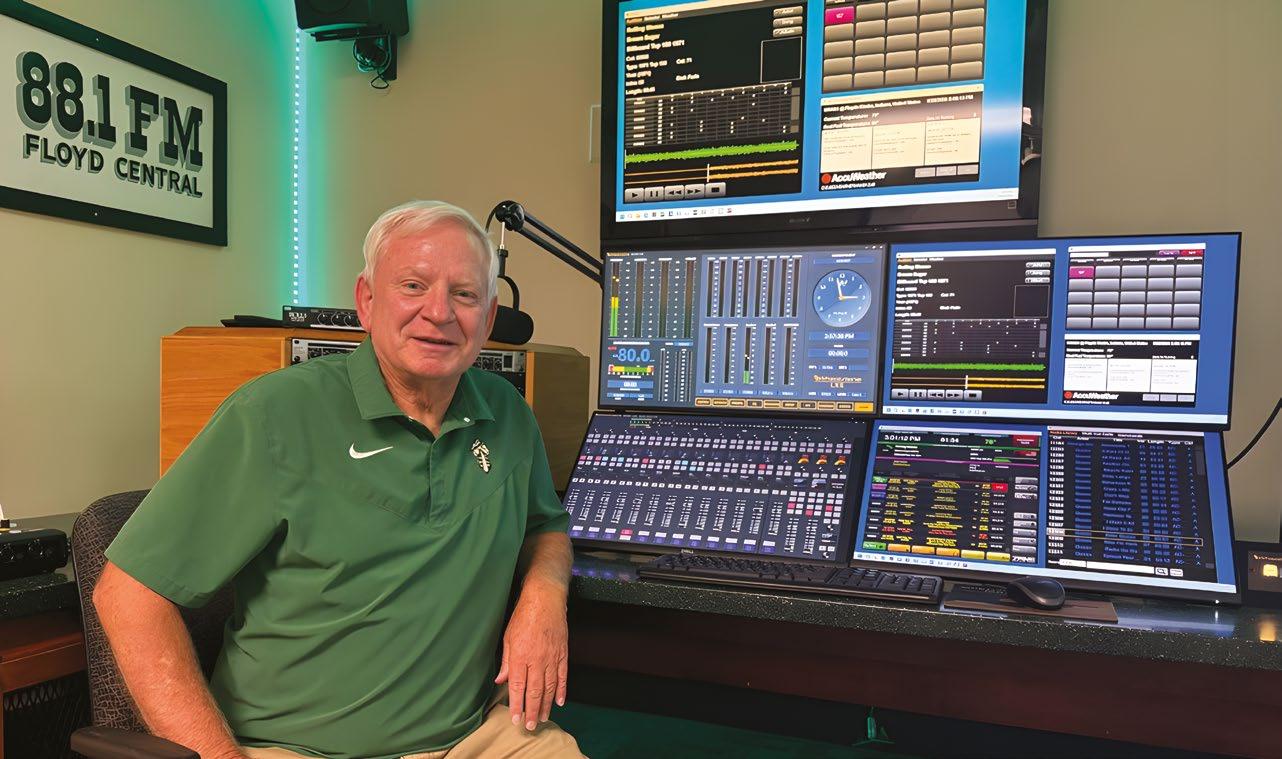
Above Tim Dench
DJB Zone Wide Area was the first component selected and the cornerstone that everything was built around when planning for the station rebuild started.
“We had to have the latest technology but it needed to be simple to use, as we get new students every year.”
DJB Technical Support designed the station’s system, loaded the software and obtained the necessary hardware. “While it is a very sophisticated system, the workflow is easy to navigate and allows us to produce a lot of content over our network,” said Dench.
RCS highlights the capabilities of its ZettaCloud playout solution for radio stations.
“Whether you’re handling live programming, automated playlists or disaster recovery, ZettaCloud provides the flexibility, reliability and scalability you need to keep your station running smoothly, with minimal downtime and maximum efficiency,” said RCS in a release.

It says ZettaCloud provides disaster recovery capabilities but is serving hundreds of stations as their main playout system, one that evolves with programming needs. The solution is designed for routine broadcasting,
live shows, spot handling and emergency takeovers, with the ability to operate across multiple platforms.
RCS says ZettaCloud provides direct integration with thirdparty services. Users can choose services such as sound processing and digital consoles; more thirdparty integrations are planned. The platform received a Radio World “Best of Show” Award at the spring NAB Show.
Info: www.rcsworks.com

Broadcast Tools Inc. is shipping its newest audio switcher, the ACS 8.4 G2.
The ACS 8.4 G2 is an 8x4 balanced analog stereo matrix switcher with eight RJ-45 audio input and four RJ-45 audio output connectors. The company says matrix switching allows any/or all inputs to be assigned to any/or all outputs.
It includes an ACS 8.2 Plus firmware emulation mode that allows it to work with automation systems designed for the ACS 8.2 Plus without the need for changes to the automation software’s configuration. Broadcast Tools says this makes the ACS 8.4 G2 a suitable choice for stations looking to upgrade to a switcher with four outputs, and/or updating to RJ-45 audio wiring standards.
The ACS 8.4 G2 features a 1RU 19-inch rack enclosure, front push-button controls, as well as 16 remote control/PIP trigger inputs compatible with contact closures, open collectors and logic outputs. Sixteen SPST relay outputs are provided to interface with external equipment.
The switcher can be controlled via built-in multi-drop RS-232 serial and/or Ethernet (TCP/UDP). Built-in Ethernet eliminates the need to purchase a separate serial-to-Ethernet device server and
makes it easy to control the switcher from automation software or from Broadcast Tools’ free switcher control/scheduling software, NetSwitch III. Other features include three audio switching modes: interlock, overlap and mix.
Internal silence sensors monitor each output and provide LED silence indicators, serial string outputs and silence alarm relay outputs. Silence sensor trip level, silence delay and restore duration timing are configurable. Audio monitoring is via stereo LED VU meters and stereo headphone output with headphone jack, level control and output selection switch.
Info: www.broadcasttools.com



Marketron says its PayNow platform consolidates the entire payments workflow from invoicing to funding. It integrates with the company’s traffic systems, “delivering a complete AR solution for broadcasters.”
Recently, two Marketron customers discussed the benefits of the platform, detailing its pre-payments, payment reminders and a collections tool.
Lotus Communications Regional Business Manager
Danielle Spaulding shared that before PayNow, cash-inadvance buys and collections were manual tasks and inefficient. With the implementation of PayNow, she said these workflows are easier and require little time.
Marketron said Spaulding has given account executives access to the collections tool, making a significant difference in outstanding invoices.
It said adoption of these tools has enabled Lotus to reduce the number of days outstanding and increase their cash flow. Spaulding cited efficiency and a reduction in the amount of time to run through the aging and ask for payments.
Separately, Forever Media AE Melissa Kubik said she uses the payment reminder tool in PayNow. “I thought it would take more time out of my day working on collections rather than selling. To my surprise, it has had the opposite effect.”
NextKast said KHYI 95.3 The Range is using its automation software.
The station serves the Dallas/Fort Worth market but it operates with limited resources for its market size, according to the supplier.
By installing NextKast, “KHYI transformed its operations, enabling dynamic music scheduling, live remotes, remote DJ shows, and built-in streaming,” the company said.

Kubrik said she can quickly send out reminders, and that such nudges work. Payments come in quicker, and she estimated that for every five she sends, she gets three payments that same week.
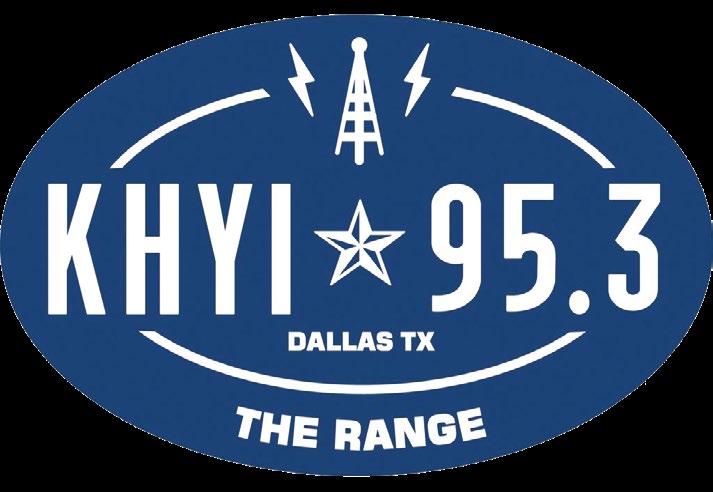
KHYI’s previous automation required add-on modules to enable features like remote broadcasting. NextKast said this became problematic during the pandemic, forcing DJs to record individual breaks, upload them to Dropbox and rely on station staff to insert each track manually. Remote shows became very complicated.
NextKast said its integrated platform is simple to learn but provides the features KHYI needed, including smart scheduling and an Audience Pleaser feature that uses real-time audience data to enhance the station’s Texas/ Americana playlist.
Voice Tracking and GoLive features enable pre-recorded and live remote broadcasting, eliminating the need for board ops during events. Streaming capability is built in.
www.nextkast.com
Radio.Cloud has released a tool intended to help stations save time when syndicated programs are imported into automation.
Content Transporter is part of the company’s Content Controller offerings. Radio.Cloud said that it is designed to insert syndicated show segments into a station’s automation playout system. The
transporter allows for last-minute changes to show segment files to be included before scheduled playback.
Andrew Scaglione, the company’s account director, said Content Transporter is web-based, like the entire Radio.Cloud operating system. Its user interface in a browser allows for both syndicators and affiliate radio stations to manage program distribution over the internet.


Radio.Cloud said that while Content Transporter works best within Radio.Cloud’s products, it can be used with any automation system. Files inserted into the tool can be of any audio format, though Scaglione recommends using WAV files.
The Content Controller suite uses AI to manage syndicated program workflows, which includes the ability to insert localized content at the beginning or end of program files. The design would allow for multiple local versions of nationally syndicated shows.

















AxelTech announced two major updates to its XRadio Radio Automation platform.
The newly-added Cart Stack system operates as an audio management hub, supporting up to eight simultaneous playback layers. The tool handles any content type, including music tracks, recorded programs, station identifications, promotional content, advertisements and sound effects.
“The interface features intuitive drag-and-drop functionality, providing direct access to both the XRadio Library and external file systems,” said AxelTech in a press release. “Broadcasters can operate in fully-automated mode for consistent programming or switch to manual control for live events and special broadcasts.”
AxelTech says remote control capabilities through GPI hardware interfaces, UDP network protocols and REST API integration accommodate diverse broadcasting environments and third-party system integration.
The other update features a newly-integrated news management system. Broadcasters can create standardized templates with timing controls, custom durations and integrated music themes.
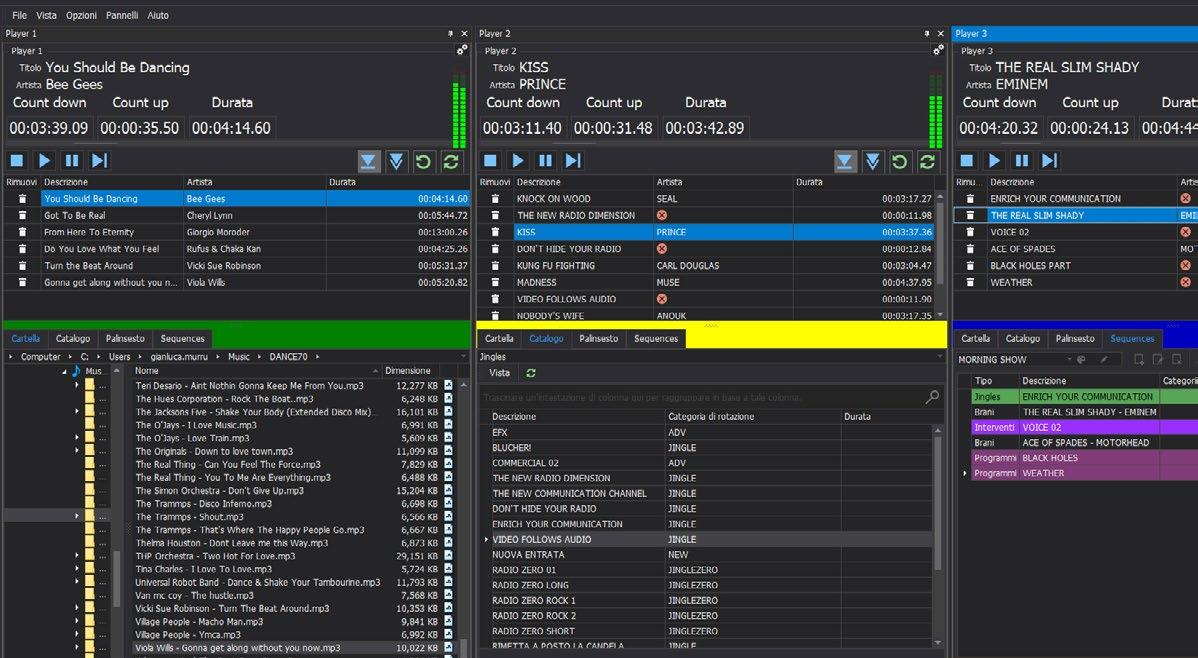
Each template supports audio branding with opening sequences, background soundscapes and closing elements.
“Producers can pre-load interview clips, correspondent reports and sound bites, then transition smoothly to live reads using the built-in teleprompter interface. Real-time prompts guide presenters through complex bulletins, ensuring consistent delivery and reducing on-air errors.”
Scheduling features automatically trigger news blocks at predetermined times, while emergency override capabilities allow breaking news insertion without disrupting the broader programming schedule.
Info: www.axeltechnology.com
Broadcast Radio is unveiling a radio scheduling system that supports most automation systems.
The U.K.-based software developer said its Myriad Schedule Pro is available as a traditional desktop application, a cloud-based web service or a hybrid application that takes advantage of both environments.
Broadcast Radio said the platform integrates with its Myriad Playout automation, allowing stations to plan music and organize events from one interface.

Users can move songs, links, promos and advertisements between scheduling and playout without replication.
But the scheduling system is compatible with other third-party automation systems and equipped with export and integration tools.
The software has a customizable clock system. Stations can build hourly clocks using a drag-and-drop interface, facilitated by logic that offers formatting by time of day, show type or genre.
The clocks are assisted by approximately 100 user-definable scheduling roles that govern song separation, artist rotation, album balance, tempo flow and other aspects, with rule sets for artist groups and related entities.
Myriad Schedule Pro includes a log review system, which identifies rule violations and provides context-sensitive alternate recommendations to help programmers correct playlist issues without affecting musical quality or flow.
The software provides support for audience engagement through its research panel and reporting suite. It can incorporate real-time listener feedback, voting data and trending analysis.
Programmers can adjust rotations based on audience sentiment.
Info: www.broadcastradio.com
Arrakis Systems said its flagship broadcast automation platform is getting a makeover.
The Colorado-based manufacturer said the Apex platform provides connectivity across multiple studios, robust voice-tracking
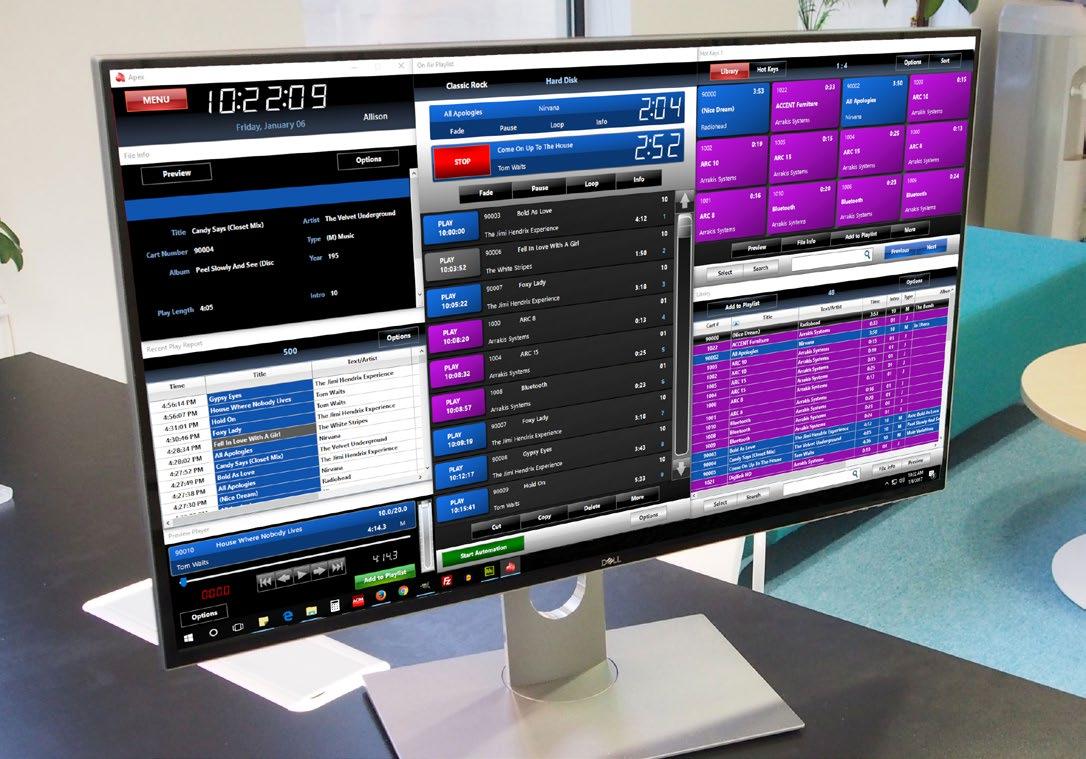
capabilities and centralized audio library management from single or networked PCs.
Recent updates to Apex include enhanced user interface personalization, allowing DJs to resize and map modules within the live “On-Air” screen, save custom layouts and access preset profiles. Its scheduling tools include clock creation, drag-and-drop sequencing, third-party import and game automation.
Arrakis said radio broadcaster Your Network of Praise selected Apex for its satellite radio expansion across Africa. “Thanks to reliable automation and responsive vendor support, the network has successfully deployed multiple systems and plans further expansion,” it said.
Arrakis said the evolution of Apex automation through UI and scheduling enhancements is a testament to its mission to keep pace with radio’s future.
“As stations embrace remote workflows, customizable interfaces and unified control systems, Apex is poised to remain a vital, constantly improving asset in the broadcaster’s toolkit.”
Info: www.arrakis-systems.com















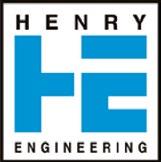

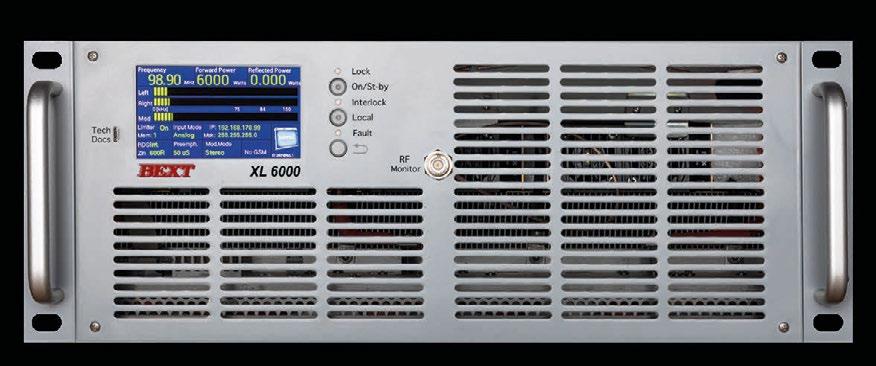


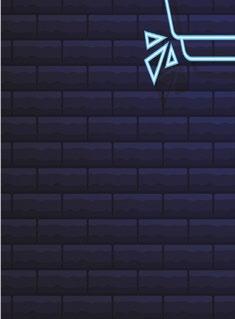



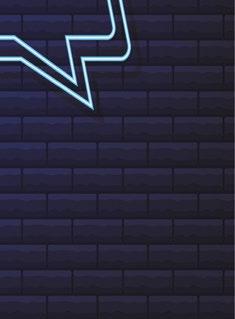
Writer

Frank M. Howell
Ph.D., K4FMH
The pending death of AM broadcasting is a common refrain these days.
Claims based on highly publicized station closings (e.g., author Stephen King), overgeneralized personal experiences, the uncertainty of AM’s presence in automobiles, sentiment surrounding the medium and miscellaneous random events have fed this narrative.
But as in the infamous obituary for Mark Twain, this corpse can still fog a mirror. Here is why I say that.
Based on the number of AM and FM station licenses over time, measured radio audience levels by Nielsen, advertising trends and other factors, my analysis shows no signs of AM broadcasting being in a nationwide death spiral. Instead, there are local media markets exhibiting difficult conditions in which to remain profitable.
Key findings include:
• The loss in the number of AM station licenses in the United States is small in historical terms. Depending on the source you use, AM station licenses have declined by about 400 from their peak in 1990, some 8.4% over 35 years. Radio World cites data giving the drop as 630 stations and 13% over that time. But these are not “falling sky” numbers.
• By my calculations the annualized percent change for AM and FM station licenses has been less than one percent for each and is largely flat since 1991. Yet, there is no clamor over FM station loss, which momentarily surpassed that of AM stations around 2020.

• Nielsen has recently published AM reach data by DMA. My analysis using GIS with spatial statistics shows which local media markets have more AM stations failing as well as those where FM station loss is significant. The Bangor, Maine, DMA, where King’s stations were located, is one of those poorly performing markets in the U.S. Yet news coverage suggested it signaled the death of AM radio.
• A surprise is that radio reach among the 18–49 age segment is some 12% higher than TV, not a sign of mortality in the offing. Podcasts? Radio dominates them in ad revenue! Combined with the high level of trust in the radio medium, AM/FM radio is doing quite well. Public data do not separate AM from FM. But these combined data points would have to be lopsided in favor of FM to produce a different conclusion.
• It is in the larger media markets where more station loss has occurred, perhaps a sign of over-built markets? FM stations also fail in many local markets, especially in larger ones. In fact, in my analysis I show that it is the size of the market that better predicts AM and FM station loss over market geographic area or audience reach. Regardless of audience size or the market area, more AM or FM stations begat more closures.
• These results lean heavily toward a local media market “shakeout” rather than a national death of AM radio. Smaller markets tend to rely more on radio, particularly AM, where some areas just do not receive FM signals well due to terrain blockage. Larger markets tend to have many more outlets for news, information and entertainment. Hence, a shakeout is the most likely culprit rather than the death of AM radio.
• Nielsen does not release DMA ad revenue separately for AM stations. If it did, we would have a more definitive answer to the most underlying ailment leading to AM (and FM) station closures. Should the company decide to do so, I will readily include them in a new study.
I have explored these arguments in detail in the August issue of The Spectrum Monitor magazine. I encourage readers to review them. Subscribers can find it at https:// thespectrummonitor.com/index.aspx. Or visit https://tinyurl. com/rw-howell
In his recent article “SDRplay Thinks Big With the nRSP-ST,” James Careless neglected to mention that softwaredefined radios have damaged the traditional hobby of DXing.
I’ve been responding for decades to letters — originally on paper, now mostly by email — from U.S. AM band signal reception enthusiasts throughout northern Europe.
With the advent of SDRs and the ability to record IQ data on hard drives or thumb drives, the DX chase is not what it once was. Back in the day, DX’ing was more luck-driven, requiring tenacity and lots of coffee, where you had to manually scan the AM dial throughout the night with a cassette recorder at your side along with pencil and paper.
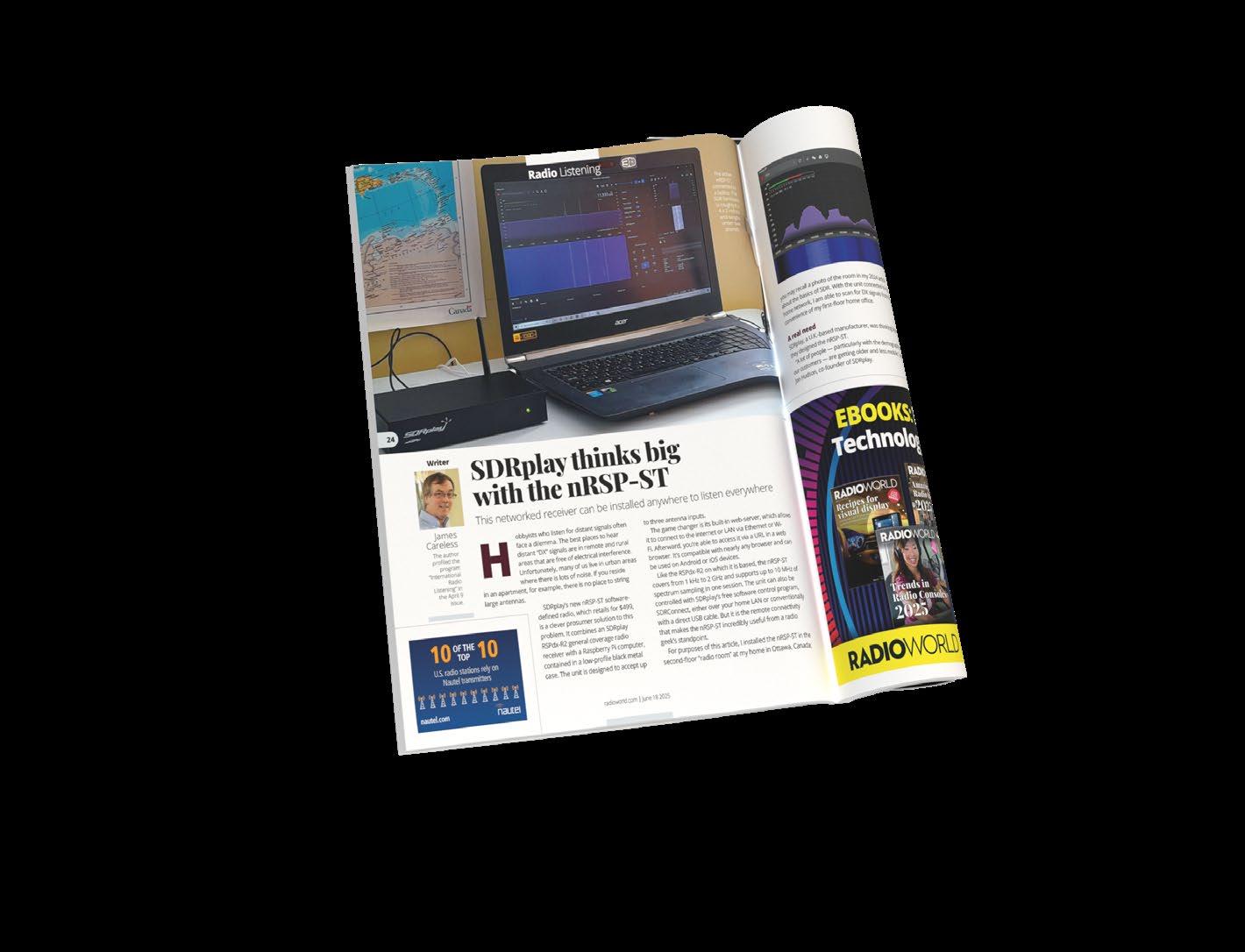
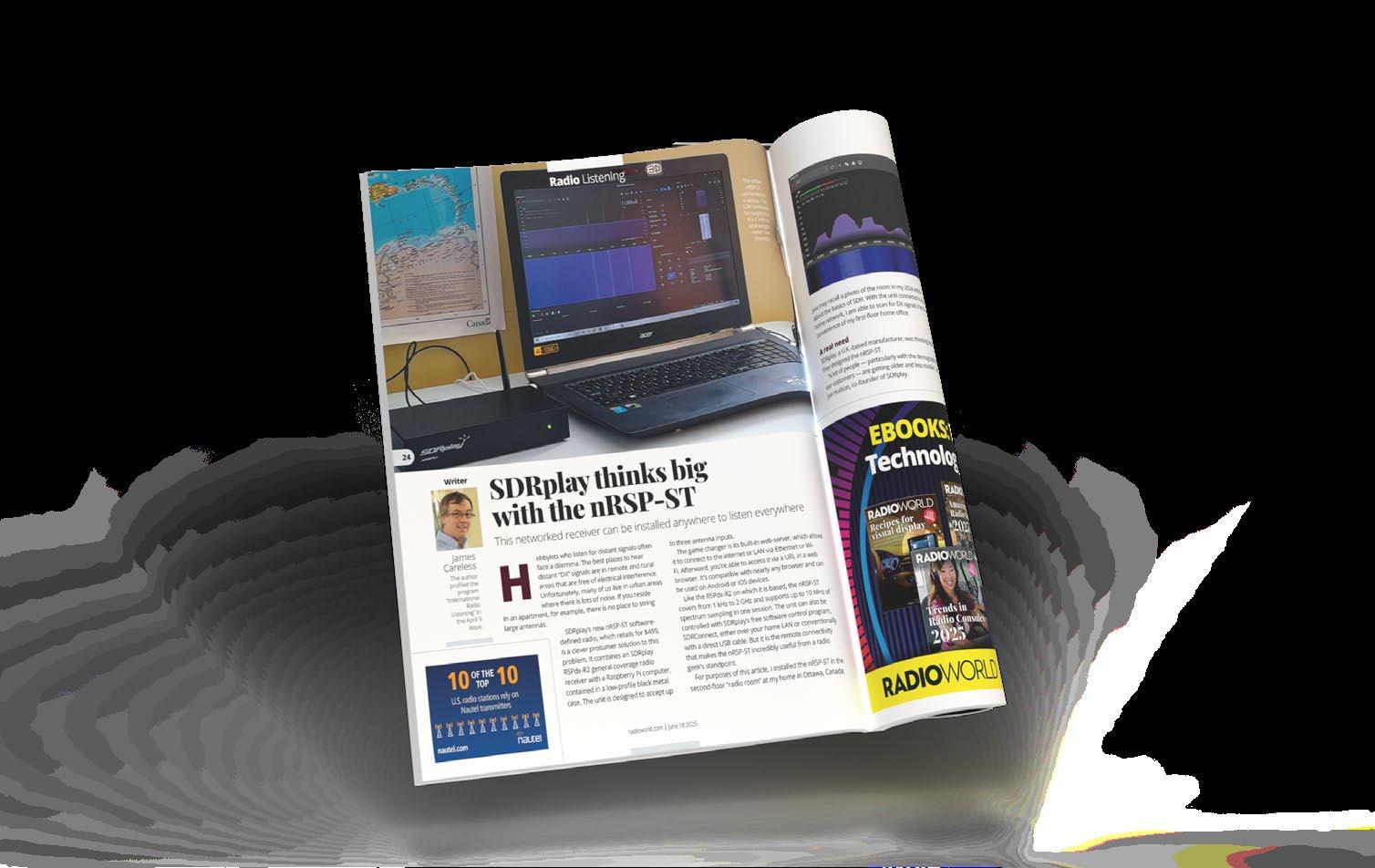
and 40 meters is now OK, but 20 meters is still unusable. I have to dig further and add a more robust EMI filter. It would be interesting to know the reasoning behind these exemptions. Normally, devices used in a residential setting are required to meet the more stringent Class B requirements. But the appliance exemption gives examples of “microwave oven, dishwasher, clothes dryer, air conditioner (central or window)”. These devices are clearly used in a residential environment and should be subject to the Class B requirements.
These days when I receive a DX report, besides verifying it, I critique their armchair prowess. How easy they have it compared to those who came before them. Instead of having to travel to remote cabins north of the Arctic Circle and try to stay awake while hunting through the noise for an audible station ID, they can ignore the whole process and many months later review the SDR data files, maybe using AI-driven software, to search all the signals across the entire AM band at once.
For sure, technological advances make life easier while the underpinnings become more complex. Just what an engineer enjoys! But are we not losing something by becoming lazier?
Ira Wilner Chief Engineer Monadnock Media Group Saga Communications Keene, N.H.
In his letter to the editor in the July 16 issue, Rolf Taylor writes that it would be interesting to see if cars meet the FCC Part 15 unintentional radiator requirements.
For some reason, Part 15.103 in Title 47 of the Code of Federal Regulations exempts “transportation vehicles” from these requirements. In addition, “A digital device utilized exclusively in an appliance” is exempt.
Our air conditioner contractor just replaced an induction motor driving the condenser fan in our air conditioner with an “electronically controlled motor.” It wiped out HF reception. I’ve added some ferrite cores on the motor leads,
How to submit Radio World welcomes comment on all relevant topics. Email radioworld@ futurenet.com with “Letter to the Editor” in the subject field.
Thanks Radio World for the recent article regarding WVMO(LP), The Voice of Monona (“10 Years In, This Wisconsin LPFM Is a Model for Community Radio,” http:// radioworld.com).
The station was six months into its first year before I started my GS2BB show — “Great Songs, Great Singers and Big Bands” — but it was already a huge success in the community.
Not all show hosts live in Monona or even in the Madison area, but 21st century technology has made it possible for some of us to originate programming from our own location and begin radio careers or revive them from days gone by.
After joining some 1,500 community members and listeners for our birthday celebration at San Damiano Park in Monona recently, seeing their enthusiasm on display and experience their dedication to the station, it is obvious that The VOICE of Monona has also become The HEART of Monona!
Rod Perry Show Host
As a teenager working weekends at an FM station in New Jersey, I bought and installed an FM converter in my dad’s pickup truck so I could listen. Now the shoe is on the proverbial other foot. Fortunately, despite auto industry EMI studies, my EV Chevrolet Bolt radio allows me to listen to clear AM with no interference. Let’s retain freedom of choice: FM and AM in our vehicles.
Ken Peach Consultant
On This Rock Communications and Former station owner
